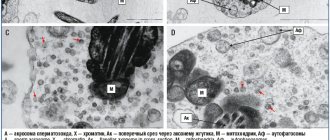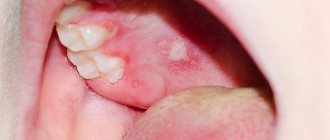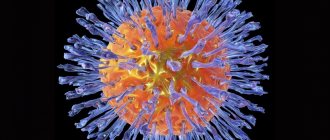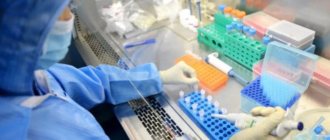Herpes is a very common viral disease, the distinctive feature of which is rashes in the form of groups of blisters on the skin and mucous membranes of a person. These bubbles (vesicles) burst over time, forming wounds that later dry out. There are several types of the virus, the most common being type I (HSV-1) and type II (HSV-2).
HSV-1, also known as herpes simplex, causes rashes mainly in the mouth, lips, face, neck and eyes.
HSV-2 is a genital herpes that affects the skin and mucous membranes in the genital area.
The disease is contagious, the main routes of transmission are contact, through the skin (for example, through kissing), sexual intercourse, through household items, and airborne transmission is also possible. The presence of diseases in which the immune system is weakened (for example, HIV), and treatment with immunosuppressants, for example after organ transplantation, contributes to the manifestation of herpes viral infection.
After the incubation period, painful blisters appear on the skin or mucous membranes and last up to four weeks. The presence of rashes is the main symptom of the disease, but there may be other manifestations similar to influenza and ARVI: chills, sore throat, itching or burning on the skin. After the symptoms disappear, the virus remains in the body and goes into a latent form, in which it can exist throughout the patient’s life. With stress or decreased immunity, the virus can become more active and a relapse occurs. In most cases, herpes is not dangerous to health, but it can have serious consequences for newborns (in the case of primary infection during pregnancy) and in immunodeficiency states.
According to WHO, up to 80% of the Russian population is infected with type I virus and about 20% with type II virus. Moreover, 90% of carriers may not even know about their infection. The presence of infection can only be determined through laboratory diagnostics. One of the most common and effective tests is an analysis for antibodies to herpes viruses types I and II.
Antibodies of the IgM and IgG classes are produced by the body in response to and to fight infection. IgM appears first, they can be detected within a few days after infection, they are a marker of acute infection and can be detected in the blood for up to several weeks.
IgG antibodies to the herpes simplex virus are usually formed 2-3 weeks after infection. The concentration of IgG in the blood increases for several weeks, then stabilizes. When a dormant viral infection is activated, the level of IgG may increase. After suffering an acute illness or as a result of asymptomatic infection, a certain level of IgG remains in a person for the rest of his life.
Detailed description of the study
Herpes simplex virus is a common viral infection caused by the herpes simplex virus (HSV). Most often it occurs in a hidden - latent, asymptomatic - form. The appearance of clinical signs of herpes infection in humans is always associated with a weakening of the body’s immune system, and the stronger the immune disorders, the more severe the disease.
In total, there are about two hundred varieties of the virus, but only 8 of them affect humans. Each type has its own characteristics. Herpes simplex viruses of the first (HSV-1 / HSV-1) and second (HSV-2 / HSV-2) types are the most studied. HSV-1 typically affects the lips, facial skin, and oral mucosa. HSV-2 - genitals.
Infection with herpes simplex virus type 1 in the vast majority of people occurs in early childhood, after the infant has lost the passive immunity received from the mother. The main route of transmission of herpes virus type 1 is contact or household contact. The virus is transmitted through saliva through poorly washed hands and shared objects.
Infection with herpes simplex virus type 2 mainly occurs through sexual contact with an infected partner. Cases of transmission of infection during childbirth have also been described, when a newborn, passing through the birth canal, comes into contact with vaginal secretions containing the virus.
Acute infection after infection may be asymptomatic or have some clinical manifestations.
Characteristic clinical manifestations of the acute form include the formation of small transparent bubbles (vesicles) on the mucous membranes of the mouth or face (HSV-1) or in the genital area (HSV-2). At the site of vesicle formation, a person feels itching and burning.
After the initial infection, the herpes simplex virus remains in the cells of the central nervous system, where its reproduction is restrained by the immune system, but when the immune system is weakened, the virus enters the blood again (relapse, reactivation). As a rule, relapse of infection occurs due to immunodeficiency due to:
- Prolonged exposure to the sun;
- Stress;
- Long-term use of glucocorticosteroid medications;
- Decreased immunity;
- HIV infections.
To diagnose a herpes virus infection, the patient is examined, and laboratory confirmation is also used, which can be carried out using classical laboratory diagnostic methods - the presence of the virus is determined in samples of biomaterial obtained from vesicles. Serological research methods are also used, which detect specific antibodies in the blood serum. Determining the stage of herpes infection is possible by classes of specific antibodies - IgM and IgG.
IgM is produced immediately after infection and serves as a marker of the acute period of the disease, IgG begins to be produced approximately 2-4 weeks after infection and can remain in the blood for many months, indicating the chronic stage of infection.
This study allows us to identify reactivation of the infection, determine the type of virus that caused the disease, and also confirm the preliminary diagnosis (herpes virus infection).
What do the test results mean?
A negative result indicates the absence of antibodies to herpes viruses types I and II, which is possible if the body has not previously been in contact with the virus. Also, antibodies are not detected if little time has passed after infection and the body has not yet had time to produce IgG class immunoglobulins. A positive result indicates a current or past infection. If the result is questionable (borderline antibody level), it is recommended to be tested for IgM antibodies to herpes simplex virus types I and II and carry out a control test for IgG after a few weeks.
Symptoms of herpes infection
If you suspect a possible infection, you should undergo examination, even if there are no signs of herpes. In most cases, the disease is asymptomatic.
Exacerbations of the disease are usually associated with stress and fatigue, decreased immunity and colds. The activity of the virus is manifested by characteristic symptoms:
- sores and crusts on the lips;
- blistering rashes on the genitals, around the anus;
- fever;
- pain and itching in areas where the mucous membrane is affected.
Manifestations of the disease affect the mucous membranes of the genitals and oral cavity. The first type of virus, when activated, forms primary gingivostomatitis or recurrent herpes, the second type becomes the source of genital herpes. Advanced disease is not limited to spreading on the lips. Herpes can colonize all mucous membranes, affecting the throat, nasal cavity, and internal organs. Herpes rashes are also possible on the face and entire body. The herpes test detects all types of infection.
Preparing for a herpes test
The biomaterial for analysis is not only blood plasma, but also scrapings of the epithelium from the affected mucosa, as well as saliva and urine. To avoid unreliable results, you should prepare for collecting material for research.
- Before taking a scraping from the urogenital area, you must stop sexual intercourse two days before the test and not urinate for two hours immediately before the procedure.
- Genital material is collected from women only after the end of menstruation.
- For other forms of research, morning urine and blood from a vein are donated on an empty stomach. At the same time, you should not take alcohol, spicy or fatty foods the day before.
Exacerbation of the disease
The first symptoms of herpes type 2 are pronounced. Then the pain, the frequency of damage to the skin and mucous membranes, as well as the duration of the inflammation itself with subsequent exacerbations decrease. In this case, in men and women, blisters and scabs do not appear, and the residual manifestation is preceded by burning and tingling in the genital area. In some cases, HSV-2 may be accompanied by slight genital discharge and difficulty urinating.
Some women and men recover from HSV-2 with few symptoms. The activity and external manifestations of herpes infection depend on the state of the immune system. Some patients may experience several phases of deterioration throughout their lives, while others struggle with it every six months. It all depends on the weakening of the body’s defenses.
As this disease progresses, patients may develop general intoxication, as well as loss of strength, decreased activity, depression, decreased performance and appetite.
Who should be tested for herpes?
In cases where there are obvious signs of disease or there is a suspicion of infection, a complex of studies of the biomaterial is carried out in the laboratory. In the remission phase and immediately after infection, the virus is difficult to recognize, so a combination of analysis methods or a series of repeated studies is carried out.
A gynecologist, urologist, and dermatologist (venerologist) are referred for testing for herpes. The analysis is prescribed for obvious signs of the disease - blistering rashes on the mucous membranes and lips, their fusion and the appearance of crusts, burning and itching in places of changes in the mucous membrane.
Women who become pregnant or are planning to have a child are required to be tested for this infection in order to prevent serious consequences. Newborns from sick mothers are also examined.
Carriers of the HIV and papilloma viruses are also tested for herpes in order to take into account its influence in further treatment tactics.
Which herpes test is better?
In modern practice, several methods for determining HSV are used:
- Culture of genital smears using cell culture followed by microscopic examination of the results obtained.
- The immunofluorescence reaction shows the presence of the virus by the reaction of test antibodies. The basis of the study is blood serum.
- PCR analysis - laboratory technicians isolate DNA fragments of the virus. The following biomaterials are used for research: scrapings from the urogenital area, morning urine, saliva, and blood serum.
- ELISA - enzyme-linked immunosorbent assay. Blood serum is examined.
To increase the reliability of the analysis, it is recommended to use not one, but several methods simultaneously or conduct repeated studies. This is due to the behavior of the virus in the body; in particular, HSV can be detected in the blood only several weeks after the alleged infection. Specific antibodies appear in different sequences and at different phases of the disease - IgM appears on the 5th day after infection and reaches a peak by the 20th day, IgG is detected from the 14th day, IgA - at a later date. The combination of antibodies shows the degree of activity of the virus and its dynamics, so the analysis is carried out at intervals - after 10-12 days.
References
- Clinical guidelines “Herpes simplex (HS) in adults” approved. Ministry of Health of the Russian Federation, 2016. - 31 p.
- Belyaletdinova, I.Kh., Golosnaya, G.S., Mitrofanova, I.V. and others - Clinical and laboratory characteristics of encephalitis caused by the herpes simplex virus in children. - Treatment and prevention, 2016. - No. 4 (20). — P.64-68.
- Khryanin, A.A. Herpes under the pillow. Prevalence of herpes simplex virus in the Russian population: long-term monitoring. – STATUSPRAESENS. Gynecology, obstetrics, infertile marriage, 2013. - No. 6. — P.69-76.
- Mathew, J., Sapra, A. Herpes simplex type 2. - StatPearls Publishing, 2022.
Determination of DNA of herpes simplex virus types 1 and 2
The study is carried out using a highly sensitive PCR (polymerase chain reaction) technique. The DNA of the virus is determined by examining a scraping from the urethra, collecting morning urine or cerebrospinal fluid. If the analysis revealed DNA fragments of herpes simplex virus type 2 or 1, this indicates the presence of a herpes infection. If viral DNA is not detected, it means that it is not present in the sample taken, or is still present there in a concentration below the sensitivity limit of the test.
In Lab4U, using laboratory methods, you can accurately determine the presence of herpes simplex virus types 2 and 1, as well as get an impression of the course of the infectious process and possible complications. All this provides the doctor with valuable information that helps in diagnosis and choice of treatment regimen.
Treatment
The following areas of treatment are currently used:
- blocking the reproduction of herpesvirus;
- symptomatic treatment to improve general well-being
- correction of the immune system.
To effectively treat the infection, antiviral drugs are used acutely and during periods of reactivation, along with symptomatic treatment. The treatment course includes virostatic drugs and interferons. When a patient has severe symptoms of infection, intravenous immunoglobulins are used to treat them.
Consequences of herpes infection
A characteristic feature of the virus is that this infection cannot be removed from the body by modern drugs, but doctors can significantly ease its course or extinguish the infection for a while, which is especially important during pregnancy.
Recent scientific research has shown that herpes is not at all harmless, as previously thought. The activity of the virus in the body can cause severe consequences:
- spontaneous termination of pregnancy (miscarriage) and premature birth;
- fading of pregnancy, increase in infant mortality by 50%;
- pathologies of the eyes and brain in the fetus;
- with simultaneous infection with the papilloma virus, the likelihood of developing cervical cancer significantly increases;
- the possibility of activation of HIV infection in virus carriers increases.
The infection is included in the group of infections potentially dangerous to the fetus (TORCH), therefore the detection of specific immunoglobulins (IgM. IgG and IgA) in the blood of the expectant mother serves as the basis for consulting a doctor about the possibility of continuing the pregnancy.







